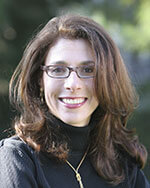Above: Ken Goldman. Jacob’s Ladder Triptych, 2015. Chromaluxe print after performance. Photos by Gideon Cohen

Robin Judd
Over the past few years, it has felt as if a significant portion of my conversations have revolved around movement and mobility. COVID-19 forced many of us to imagine alternatives to travel and to take into consideration new precautions and restrictions when it came to movement. What once seemed fixed disappeared, and many of us quickly discovered new vectors of interconnectedness among places, people, movement, and things. We all have learned new ways of being, doing, and traveling.
As COVID-19, climate change, and war have disrupted our relationships to travel and place, many of us have asked, what does travel look like? If travel has long helped us reimagine one another and ourselves, we have pondered what happens when our relationships to movement become unsettled.
The contributions to this exciting issue of AJS Perspectives push us to think critically and deeply about the many meanings, experiences, and implications of travel, as well as its multiple actors. As Joshua Shelly points out in his analysis of Arnold Zweig’s The New Canaan, a 1925 “travelogue” of Palestine, texts can take readers and writers on imaginative journeys. For the past few years, editors Chaya Halberstam and Mira Sucharov have taken us on multiple imaginative journeys. Whether in their first issue as editors when they brought together diverse authors to tackle the patriarchy or in their most recent issue when they introduced the vital possibilities of Jewish artistic culture, the two have addressed rich and varied themes. In this issue, the editors have curated a dizzying array of contributors whose diverse voices explore the movement of humans and nonhumans, documents, texts, and physical devices. Using the lens of travel, the artists, poets, and writers included here touch on the intersection of mobility with identities, relationships, consumptions, the body, gender, memory, history, and language.
As I read this issue, I kept revisiting our recent board conversations concerning what movement, travel, and access mean for our different AJS communities. AJS staff and leadership continue to think seriously about how our members’ understandings and experiences of travel can factor into our planning and programming. This summer, we begin the first phase of our strategic planning process. For us to create an intentional roadmap for the future of the AJS, I hope you will let us know what matters to you, how your experiences of movement and travel might inform our organization’s planning, and how the AJS might support your work as you embark on your future journeys.
Robin Judd
The Ohio State University